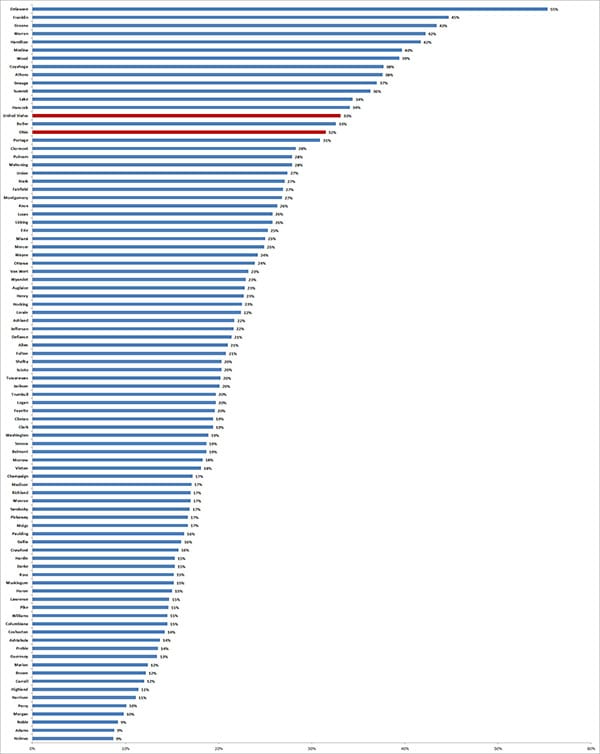Most American teenagers plan to head off to college after high school. In my organization’s recent survey of over 2,000 U.S. adolescents, a strong majority reported plans to attend a four-year university (62 percent), while another quarter said they’ll attend a two-year college or trade school. According to survey data from Learning Heroes, 75 percent of parents expect their own child to earn a college degree. Almost 70 percent of high school graduates do in fact matriculate directly to college.
Kids’ and parents’ aspirations are admirable, as data show that adults holding bachelor’s degrees tend to fare better. A four-year degree is associated with higher lifetime earnings, lower unemployment rates, higher rates of homeownership, and more lasting marriages. While there are many “good jobs” available to people without a bachelor’s degree, it’s still a good bet to earn such a credential.
But how many of Ohio’s young adults have actually made it “to and through” college?
Data from the 2011-15 American Community Survey indicate that 32 percent of Ohio’s 25 to 34 year olds—“millennials” roughly speaking—hold a bachelor’s degree or higher. This proportion falls just below the national average of 33 percent; in relation to other large Midwestern states, Ohio lags behind Illinois (39 percent) and Pennsylvania (37 percent) and is more on par with Wisconsin (33 percent) and Michigan (31 percent) in terms of college attainment. These data include both “home grown” college grads as well as young people from outside of the state who migrate there.

Chart: Percent of 25–34 year olds with a bachelor's degree or higher, Ohio counties
Note: These are estimates with a margin of error typically in the range of +/- 2 to 5.
(Click to view the chart at a larger resolution.)
Even more striking, however, is the variation in college-educated millennials by Ohio county. As the chart here indicates, several counties in Ohio have relatively large populations of college-educated young people: The rates top 40 percent in Delaware, Franklin, Greene, Warren, Hamilton, and Medina counties. Not surprisingly, these are major metropolitan areas where the employment opportunities are likely the greatest. (Columbus is in or near Delaware and Franklin counties; Cincinnati is in or near Greene, Warren, and Hamilton; and Cleveland is near Medina.) At the lower end of the spectrum is a large number of Ohio counties—mainly representing small town and rural areas—where fewer than one in four young adults hold bachelor’s degrees, attainment rates that are below the national and state averages. To be certain, this excludes those who have earned an associate’s degree,[1] but the overall picture of college attainment among young adults is still grim across broad swaths of Ohio.
What to make of these data?
First, it’s striking to note the disparity between college aspirations and actual degree attainment. While the recent survey data cited in the introduction reflect the hopes of current students, surveys of high school seniors going back to 2000—thirty-five-year-olds today—also find strong majorities (about 70 percent) saying they expect to complete college.
Second, the regional variation across Ohio in its college-educated workforce could have implications for economic growth. Again, many good careers don’t require a bachelor’s degree—and perhaps a greater share of job opportunities in more rural locales can be met with something less than a four-year degree (but probably require more than a high-school education). By the same token, the fact that in some regions of Ohio, vast majorities of young adults don’t hold a college degree remains troubling. As data from the Greater Ohio Policy Center indicate, many small towns already suffer from high unemployment rates and population loss. While the labor markets and culture of these regions differ from metropolitan areas, the data raise questions around whether these communities can compete economically without a substantial, college-educated workforce.
Third, it would be helpful to better understand why college attainment rates are so low across parts of Ohio. Certainly much of it is explained by economics—jobs for college-educated people aren’t as plentiful, and they simply migrate to places where the opportunities are. But how much of the low rates reflect other factors? A recent article from the Hechinger Report suggests that some rural students feel discouraged from pursuing college, potentially explaining the lower matriculation rates among lower-income rural students. Those who do enroll might face greater roadblocks to completion such as the costs of higher education or inadequate academic preparation; this may in turn lead to lower rates of college persistence among students from poorer rural areas.
The news on the college-attainment front isn’t all bleak for Ohio. Statewide, there has been an uptick in bachelor’s degree attainment, which stood at 29 percent among 25-34 year olds in the 2005-09 ACS data; most counties also saw modest increases in this same timeframe. Nevertheless, the low attainment rates in various parts of Ohio raise interesting questions, as does the divergence between high school students’ college aspirations and reality. In the end, Ohioans should ask what it would take to ensure that a next generation of young people has the ability to make it all the way through a post-secondary education program—whether collegiate or vocational—that can set them up for a lifetime of success.
[1] Associate’s degree data are not available by age group; about 8 percent of all adults (25 and older) in Ohio hold an associate’s degree as their highest level of education.
